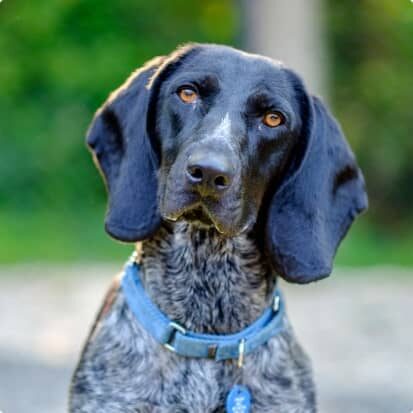House training is an important skill to teach your new puppy! Dogs that are not house trained combined with a general lack of good manners is the number one reason most dogs are returned and/or surrendered to local shelters. If you take the time (and patience) to teach these skills from the moment you get your new puppy home, the rest of you and your puppy’s lives together can be significantly easier. This can be a fairly easy training process as long as you follow our tips and practice consistency.
Potty Outside from the Beginning:
- From the first day, take your puppy outside to do their business.
- Unless absolutely necessary, avoid indoor potty set-ups (potty pads or grass patches). If these techniques must be used, then wean away from this method as soon as possible. Using these methods and then expecting puppies to switch to outside potty situations can lead to confusion.
Throw a Party:
- EVERY time your puppy goes to the bathroom outside, celebrate. But make sure you celebrate with a lowercase “c” so you don’t startle your puppy. You definitely don’t want to make them scared of performing the elimination process while you are around (aka, when you take them out). Celebrate using an upbeat voice, in gentle tones and follow through with a treat or two.
- Continue the potty celebration by doing something fun immediately after they have finished going to the bathroom. Do something enjoyable like going for a walk, engaging in play, off-leash fun in an enclosed space or free-play in a larger area of the home. By continuing the party, your puppy will learn that finishing their potty business does not have to mean that their fun ends by going straight back to their crate or losing out on their interaction with you.
Limited Access (aka, Earn the Right to more of the House):
- The biggest house training mistake is giving your puppy too much space too fast before they have settled into the routine of your household.
- It is instinct for pups to eliminate away from their nest/den and to keep their primary area clean and dry.
- If you give your puppy too much space to roam while unsupervised they might just pick an area far enough away from their bed to do their business. Even when they are supervised, if you are not paying close enough attention and reading their signals, you may miss the message that they need to be taken outside.
- Once your puppy has learned that outside is the appropriate area for potty business (and not to chew on inappropriate household items) then you can start to open up their access to other portions of your house.
Starting with the Small Space:
- When the puppy is going to be taken out less frequently (during the night or while you’re away at work), offer the puppy a smaller sleeping space. This could be a crate that is just large enough to allow the pup to easily stand up, turn around and lie down.
- During the daytime, when the pup is likely to be more active and taken out more often, you can create a larger play area. This could be a slightly larger gated area, an area enclosed by an x-pen or a play-pen area. The flooring should initially be a nonabsorbent surface (linoleum, tile or a sturdy tarp) and free of soft surfaces such as carpet, blankets and rugs (except for the puppy’s bed. Basically, it should be an area that is easy to clean and away from anything that could cause you frustration because of accidents (remember, they are just a puppy and just learning).
- Also, if you are gone for long periods of time (work, school, etc.) don’t expect your puppy/dog to be able to hold it comfortably, for more than 4 hours. Make sure to arrange for some type of midday break. Ask family members, friends and/or arrange for a dog walker to help them keep to a consistent, healthy schedule.
- Alternatively, if supervised, they can be confined to an area by keeping your puppy tethered with a harness and leash to their person or to a sturdy, stationary object (couch leg). Remember, this method of confinement should only be used when the puppy can be supervised.
Consistent Schedule:
- Every time the puppy wakes up from sleeping/napping they need to be taken outside to eliminate. Do this immediately, DO NOT delay!
- When they wake up, carry your puppy or get them leashed up and quickly go outdoors to their potty area.
- When you get to their potty area, calmly walk your pup around. Try to remain as uninteresting as possible so that you don’t divert your pup from the task at hand. Save all the attention for the potty party.
- Limit the bathroom break to 5 minutes. If the puppy doesn’t do their business, calmly go back indoors (to their confinement area) and take them back out 15 minutes later to try again. Make sure to keep an eye on them to watch for signals that they might need to go out sooner.
- Optional, but very helpful, teach a cue for elimination:
- You can teach your pup to go to the bathroom more promptly by adding a cue to the behavior.
- Start by saying the cue right as the dog eliminates and/or when they squat or lift their leg.
- After a few times of the above pairing, start to say the cue just before your pup starts to eliminate (ie, spinning in a circle, sniffing with intent, tucking their hindquarters)
- Once your cue has been paired enough times with elimination, it can be used to request the behavior.
How Long Between Potty Breaks:
- These are just puppies so don’t expect impressive bladder capacity to start. A puppy can only reasonably be expected to hold it between eliminations for 1 hour for every month of age, plus 1.
- This means a 2 month old puppy can hold it up th 3 hours or a 3 month old puppy can wait up to 4 hours.
- This guideline offers an upper limit for sleeping/resting hours. This means you might need to plan a few middle of night ventures until your puppy proves they can hold it as well as sleep through the night.
- Activity and exercise will cause your pup to need more frequent potty breaks (ie, waking from a nap, playing, eating and/or drinking). Also, never withhold water in an attempt to increase the length of time between potty breaks. This can be damaging to your puppy’s/dog’s health.
Accidents Will Happen:
- If an accident happens (I can almost guarantee that they will happen), keep calm. Move your puppy to another area to keep them out of the mess while you clean it up.
- Use a cleaning product that sanitizes and removes stains as well as any residual odors. You need a deep clean not just something that masks the scent.
- Odor creating molecules, from previous accidents, must be broken down and removed or the scent will prompt future eliminations in this area.
NEVER Punish:
- NEVER punish your dog or puppy for going to the bathroom indoors. Punishment does not teach your puppy what you want them to do and is more likely to teach your puppy that you are not safe and possibly a danger.
- Punishment makes it more likely that your dog/puppy will choose to use the bathroom in a spot hidden from you. Because you’ve shown them, by using punishment, that it is unsafe to eliminate while they are around you.
- If you happen to catch them starting the process of elimination while indoors (starting to squat, strong sniffing) use attention getting methods (gentle clap, kissy noises) that will get their attention without scaring them. Immediately pick them up or clip their leash and redirect your pup to the outdoors. When they complete their business outdoors make sure to give them a reward to reinforce outside as the appropriate place to go to the bathroom.


